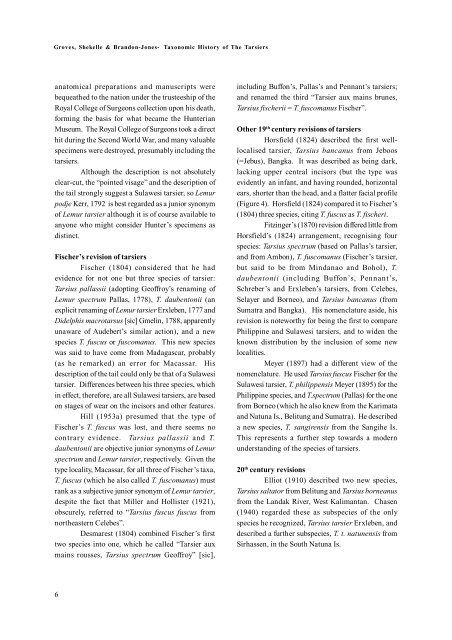Colin Groves, Myron Shekelle, & Douglas Brandon-Jones - Tarsier.org
Colin Groves, Myron Shekelle, & Douglas Brandon-Jones - Tarsier.org
Colin Groves, Myron Shekelle, & Douglas Brandon-Jones - Tarsier.org
You also want an ePaper? Increase the reach of your titles
YUMPU automatically turns print PDFs into web optimized ePapers that Google loves.
<strong>Groves</strong>, <strong>Shekelle</strong> & <strong>Brandon</strong>-<strong>Jones</strong>- Taxonomic History of The <strong>Tarsier</strong>s<br />
anatomical preparations and manuscripts were<br />
bequeathed to the nation under the trusteeship of the<br />
Royal College of Surgeons collection upon his death,<br />
forming the basis for what became the Hunterian<br />
Museum. The Royal College of Surgeons took a direct<br />
hit during the Second World War, and many valuable<br />
specimens were destroyed, presumably including the<br />
tarsiers.<br />
Although the description is not absolutely<br />
clear-cut, the “pointed visage” and the description of<br />
the tail strongly suggest a Sulawesi tarsier, so Lemur<br />
podje Kerr, 1792 is best regarded as a junior synonym<br />
of Lemur tarsier although it is of course available to<br />
anyone who might consider Hunter’s specimens as<br />
distinct.<br />
Fischer’s revision of tarsiers<br />
Fischer (1804) considered that he had<br />
evidence for not one but three species of tarsier:<br />
Tarsius pallassii (adopting Geoffroy’s renaming of<br />
Lemur spectrum Pallas, 1778), T. daubentonii (an<br />
explicit renaming of Lemur tarsier Erxleben, 1777 and<br />
Didelphis macrotarsus [sic] Gmelin, 1788, apparently<br />
unaware of Audebert’s similar action), and a new<br />
species T. fuscus or fuscomanus. This new species<br />
was said to have come from Madagascar, probably<br />
(as he remarked) an error for Macassar. His<br />
description of the tail could only be that of a Sulawesi<br />
tarsier. Differences between his three species, which<br />
in effect, therefore, are all Sulawesi tarsiers, are based<br />
on stages of wear on the incisors and other features.<br />
Hill (1953a) presumed that the type of<br />
Fischer’s T. fuscus was lost, and there seems no<br />
contrary evidence. Tarsius pallassii and T.<br />
daubentonii are objective junior synonyms of Lemur<br />
spectrum and Lemur tarsier, respectively. Given the<br />
type locality, Macassar, for all three of Fischer’s taxa,<br />
T. fuscus (which he also called T. fuscomanus) must<br />
rank as a subjective junior synonym of Lemur tarsier,<br />
despite the fact that Miller and Hollister (1921),<br />
obscurely, referred to “Tarsius fuscus fuscus from<br />
northeastern Celebes”.<br />
Desmarest (1804) combined Fischer’s first<br />
two species into one, which he called “<strong>Tarsier</strong> aux<br />
mains rousses, Tarsius spectrum Geoffroy” [sic],<br />
6<br />
including Buffon’s, Pallas’s and Pennant’s tarsiers;<br />
and renamed the third “<strong>Tarsier</strong> aux mains brunes,<br />
Tarsius fischerii = T. fuscomanus Fischer”.<br />
Other 19 th century revisions of tarsiers<br />
Horsfield (1824) described the first welllocalised<br />
tarsier, Tarsius bancanus from Jeboos<br />
(=Jebus), Bangka. It was described as being dark,<br />
lacking upper central incisors (but the type was<br />
evidently an infant, and having rounded, horizontal<br />
ears, shorter than the head, and a flatter facial profile<br />
(Figure 4). Horsfield (1824) compared it to Fischer’s<br />
(1804) three species, citing T. fuscus as T. fischeri.<br />
Fitzinger’s (1870) revision differed little from<br />
Horsfield’s (1824) arrangement, recognising four<br />
species: Tarsius spectrum (based on Pallas’s tarsier,<br />
and from Ambon), T. fuscomanus (Fischer’s tarsier,<br />
but said to be from Mindanao and Bohol), T.<br />
daubentonii (including Buffon’s, Pennant’s,<br />
Schreber’s and Erxleben’s tarsiers, from Celebes,<br />
Selayer and Borneo), and Tarsius bancanus (from<br />
Sumatra and Bangka). His nomenclature aside, his<br />
revision is noteworthy for being the first to compare<br />
Philippine and Sulawesi tarsiers, and to widen the<br />
known distribution by the inclusion of some new<br />
localities.<br />
Meyer (1897) had a different view of the<br />
nomenclature. He used Tarsius fuscus Fischer for the<br />
Sulawesi tarsier, T. philippensis Meyer (1895) for the<br />
Philippine species, and T.spectrum (Pallas) for the one<br />
from Borneo (which he also knew from the Karimata<br />
and Natuna Is., Belitung and Sumatra). He described<br />
a new species, T. sangirensis from the Sangihe Is.<br />
This represents a further step towards a modern<br />
understanding of the species of tarsiers.<br />
20 th century revisions<br />
Elliot (1910) described two new species,<br />
Tarsius saltator from Belitung and Tarsius borneanus<br />
from the Landak River, West Kalimantan. Chasen<br />
(1940) regarded these as subspecies of the only<br />
species he recognized, Tarsius tarsier Erxleben, and<br />
described a further subspecies, T. t. natunensis from<br />
Sirhassen, in the South Natuna Is.


